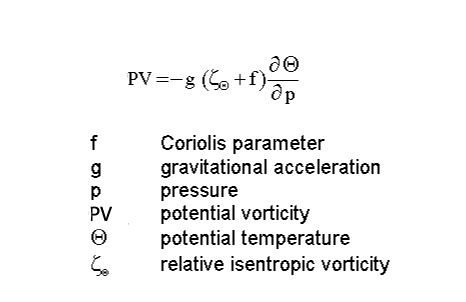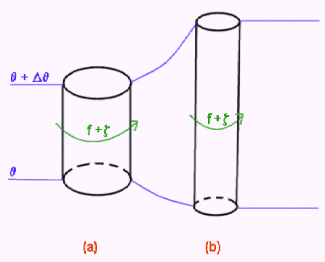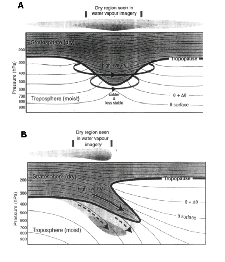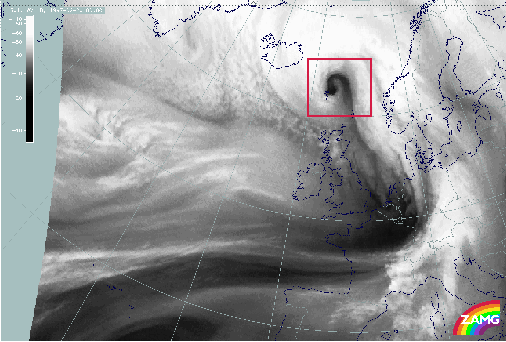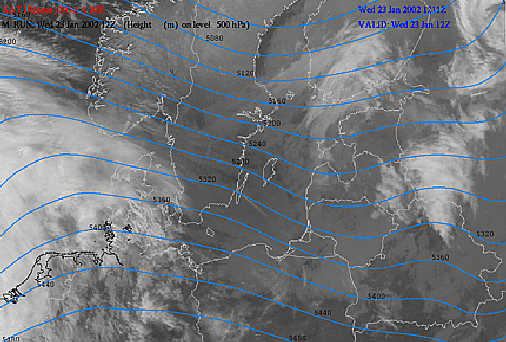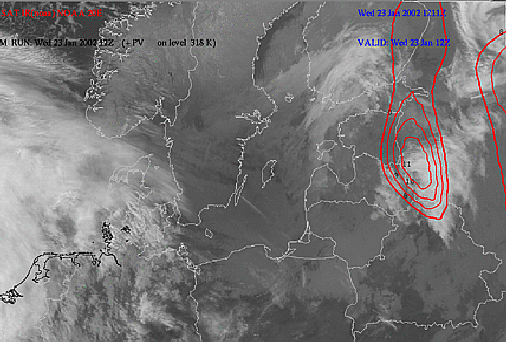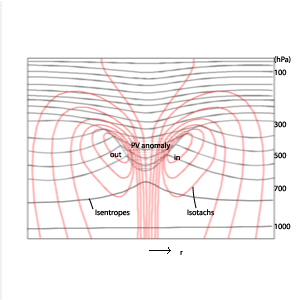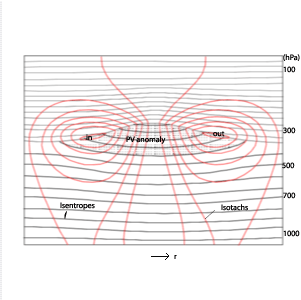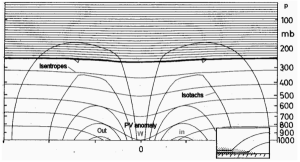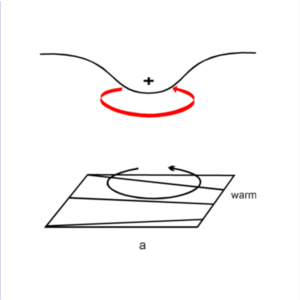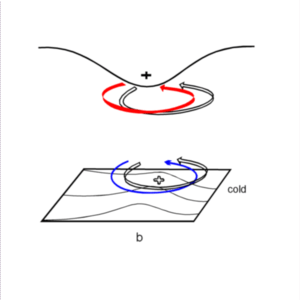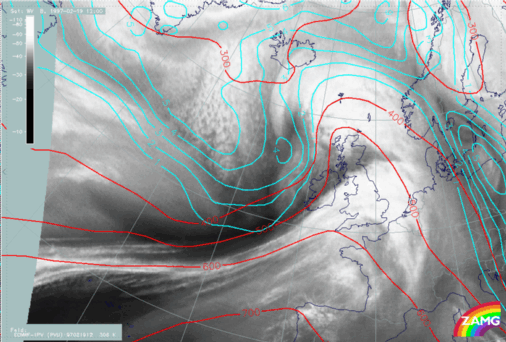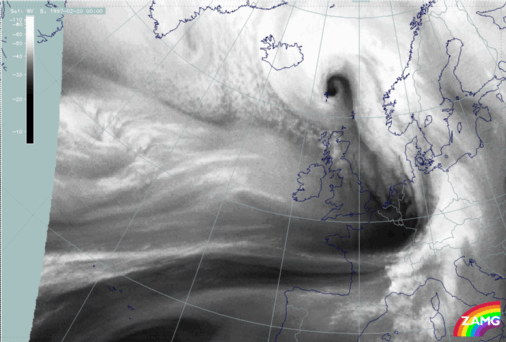Potential Vorticity
Definition and characteristics of Potential Vorticity
The potential vorticity (PV) is the absolute circulation of an air parcel that is enclosed between two isentropic surfaces. If PV is displayed on a surface of constant potential temperature, then it is officially called IPV (isentropic potential vorticity). Of course, PV could also be displayed on another surface, for example a pressure surface. Note from the relation below, that PV is simply the product of absolute vorticity on an isentropic surface and static stability. So PV consists, in contrast to vorticity on isobaric surfaces, of two factors, a dynamical element and a thermodynamical element.
Within the troposphere, the values of PV are usually low. However, the potential vorticity increases rapidly from the troposphere to the stratosphere due to the significant change of the static stability. Typical changes of the potential vorticity within the area of the tropopause are from 1 (tropospheric air) to 4 (stratospheric air) PV units (10-6 m2 s-1 K kg-1). Today in most of the literature the 2 PV unit anomaly, which separates tropospheric from stratospheric air, is referred to as dynamical tropopause. The traditional way of describing the tropopause, is with use of the potential temperature or static stability. This is only a thermodynamical way of characterising the tropopause. The benefit of using PV is that the tropopause can be understood in both thermodynamic and dynamic terms. An abrupt folding or lowering of the dynamical tropopause can also be called an upper PV-anomaly. When this occurs, stratospheric air penetrates into the troposphere resulting in high values of PV with respect to the surroundings, creating a positive PV-anomaly. In the lower levels of the troposphere, strong baroclinic zones often occur which can be regarded as low level PV anomalies.
It must be stressed that this other way of looking at the dynamics of the atmosphere will not necessarily result in new conclusions. However, it may give new dimensions to things that in fact were already known.
The two main advantages of potential vorticity (with certain assumptions) are:
- Conservation
- Invertibility
The two advantages will be discussed briefly:
Conservation
With the following assumptions PV is a conserved parameter
- Adiabatic stream (no diabatic heating or cooling)
- No friction
- Homogenous
- Non-compressing
A first mathematical consequence of the conservation can be derived from the definition of PV: A parcel will keep the same value of PV if it moves along an adiabat through the atmosphere thus the equation for PV can be written as:
Due to the conservation of PV, there is a close relationship between absolute vorticity and static stability. The diagram below shows a cylinder with the top and bottom defined by two isentropic surfaces. Difference in potential temperature between the top and bottom is the same for the two cylinders. If PV is conserved, and the cylinder is stretched as shown in (b), then static stability is decreasing and absolute vorticity must increase. Alternatively, if one goes from (b) to (a), then static stability is increasing and absolute vorticity must decrease.
Due to the conservation of PV, significant features that are related to synoptic scale weather systems can be identified and followed in space as well as in time. This is a very powerful characteristic of this property. Especially the case of a lowering of the dynamical tropopause, the upper PV - anomaly can be followed in time and space rather easily. PV anomalies are well related to a lot of dynamical processes in the troposphere. A distinct example of this are cases of Rapid Cyclogenesis where PV - anomalies play an important role.
The sudden creation or destruction of PV means that diabatic processes are involved (release of latent heat, friction, radiation). This fact can be used as tool to identify or even quantify the influence of these processes.
Invertibility
The second advantage of PV, invertibility, is a very important tool, because it allows one to obtain familiar meteorological fields, like the geopotential, wind, temperature and the static stability, when the distribution of the PV and the boundary conditions, potential temperature at the surface, are known. Further with the help of the invertibility it is possible to quantify the importance of PV-anomalies and the strength of their associated circulation and/or temperature pattern.
Potential Vorticity and Water Vapour imagery
There is a clear relation between PV and water vapour imagery. A low tropopause can be identified in the WV imagery as a dark zone. As a first approximation, the tropopause can be regarded as a layer with high relative humidity, whereas the stratosphere is very dry, with low values of relative humidity. The measured radiation temperature will increase if the tropopause lowers. This is because of the fact that the radiation, which is measured by the satellite, comes as a first approximation from the top of the moist troposphere. High radiation temperatures will result in dark areas in the WV imagery. The upper PV-anomaly and its appearance in the WV imagery can have different shapes, which is illustrated in the schematics below.
Situation (a) is the appearance in WV imagery in case of a circular cyclonic upper level PV - anomaly. In the WV image this anomaly is represented as a black shaded area which gradually becomes grey at the edges. Typical examples are WV eyes (compare Water Vapour Vortices ).
Situation (b) is the appearance in the WV imagery in the case of a frontal zone. Most striking here is the shape of the PV-anomaly: The tropopause has been folded in this situation. This can be seen as a discontinuity in the pixel values of the WV imagery. So a sudden change from low to high pixel values can be expected. Typical examples are dark stripes (compare Dark Stripes). In the situation shown below, an example of a sudden change in pixel value can be seen in the red rectangle.
PV fields can also be used to detect the discrepancies between numerical models and observations because of the tight relationship between PV and WV.
More structure than isobaric analyses
Analyses of PV appear to have more structure than height analyses on an isobaric surface. The reason for this is a mathematical consequence of the dynamical principles. The horizontal gradient of PV is related to the second derivatives of the wind field with respect to both the horizontal and the vertical co-ordinate variables. The wind field is thus the inverse Laplacian of the derivative of the PV field. Since the laplacian acts as a smoother, the wind field must be smoother than the PV gradient field. If the gradient wind formula is examined, one can establish that the wind is related to the gradient of the geopotential height. Therefore the PV field is related to second derivatives of the geopotential height, and must show a lot more structure than the geopotential height field. The practical consequence is that using PV can identify e.g. short wave troughs in the geopotential height field more easily. Since fast-moving troughs can influence weather dramatically, PV is a useful tool to notify this kind of small-scale structures.
|
23 January 2002/12.00 UTC - NOAA IR image (channel 4); blue: geopotential height 500 hPa
|
23 January 2002/12.00 UTC - NOAA IR image (channel 4); red: potential vorticity 318K
|
The left image above shows a small trough over the Baltic States in the geopotential height field at 500 hPa. It can be seen that the trough coincides with an enhanced cloud feature just ahead of the trough axis. The PV field in the right image shows that this small trough is accompanied by a very distinct PV maximum in front of it.
PV-Anomalies
In the previous chapters, it has been mentioned that a lowering of the tropopause is called an upper level PV-anomaly. These anomalies are characterised in the WV imagery as dark shaded areas, which can occur with different shapes. It has also been noted that the PV field induces all other meteorological fields because of the invertibility principle. The characteristics of an upper-level PV anomaly are now examined in more detail. Therefore a cross section through an idealised cyclonic eddy will be examined:
Under the assumption of a three dimensional balance between the fields of mass, pressure and wind, positive PV anomalies are connected with cyclonic vorticity and negative PV anomalies with anticyclonic vorticity.
- In the case of a positive PV anomaly, the isentropes are characterised by higher values than in the surrounding areas (indicating colder air). The height of the tropopause has a local minimum. The corresponding pressure and wind field shows an area with low pressure and a cyclonic circulation.
- In the case of a negative PV anomaly, the isentropes are characterised by lower values than in the surrounding areas (indicating warmer air). The height of the tropopause has a local maximum. The corresponding pressure and wind field shows an area with high pressure and an anticyclonic circulation.
From the diagrams above it can be seen that an upper PV-anomaly is perturbing the wind and pressure fields throughout the whole depth of the troposhere. The effect of the perturbation is proportional to the horizontal scale of the anomaly and inversely proportional to static stability (see the PV equation).
Investigations have also shown the existence of low level PV-anomalies These anomalies do not have stratospheric origin but are being formed in strong baroclinic zones where much release of latent heat takes place. However, these PV-anomalies are frequently invisible in satellite imagery. But, recent studies have shown their existence in both observations and model fields. For a closer look at the characteristics of a low-level PV-anomaly a cross section through an idealised cyclonic eddy is examined:
In the case of a positive PV anomaly, the isentropes are characterised by higher values than the surroundings. Therefore the isentropes have to curve downwards because, in general, potential temperature increases with height. The corresponding pressure and wind field show an area with low pressure and a cyclonic circulation.
In an idealised anomaly, the isentropes do not stop at the surface but follow the surface closely at the low levels. This can be seen in the embedded enlargement in the schematic above. Therefore, near the earth's surface the static stability is relatively high, as is the potential vorticity. Due to the thermal gradients on both sides of the anomaly there must be a wind maximum at the level where the anomaly has its maximum. This is a consequence of the thermal wind which implies that vertical wind gradients and horizontal temperature gradients are related. The wind field throughout the whole depth of the troposphere can be induced by a low-level PV - anomaly. This idea is actually analogous to the concept of the upper level PV-anomalies.
The material conservation, combined with the advantage of invertibility is very useful to describe complex dynamic processes. For example Rapid Cyclogenesis, and other conceptual models can be described using PV. Research indicates that Rapid Cyclogenesis can be explained by an interaction between low and upper level PV-anomalies. When the phase difference between two PV-anomalies has an optimum value, interaction followed by mutual amplification takes place. Of course the opposite can also occur, in the case of decaying cyclones.
If an upper level PV-anomaly develops, then as a consequence of the PV equation, positive vorticity is released and high PV values from the stratosphere influence the less stable environment of the troposphere. The assumption for the figures above is that that an upper-level, positive PV-anomaly is being advected over a zone of strong, low-level equatorward temperature gradient describes a situation where an originally small-scale upper level trough moves over a zonally oriented surface Cold Front. The left figure (a) shows such a situation with the solid + sign indicating the upper level PV-anomaly.
The thick solid arrow around the PV maxium indicates the cyclonic rotation. This rotation is induced at lower levels of the baroclinic zone as shown by the thin solid circulation arrow. This low level circulation causes warm advection ahead leading to a low level positive temperature anomaly indicated by the open + sign in the right figure (b). This temperature anomaly is associated with a cyclonic vortex which is marked by the open arrow at low levels.In turn, this circulation has a positive feedback to the upper troposphere, shown by an open circulation arrow at higher levels.
In parallel a second process is taking place: The induced low level vortex results in a strong equatorward wind component under the upper level PV anomaly. This southward component also influences the higher levels and leads to an equatorward advection of the upper level PV-anomaly which in turn intensifies the upper level Wave.
Within this increased flow higher PV values to the west of the PV-anomaly are advected southward and lower PV values to the east of the PV-anomaly are advected northward. As a consequence of the latter process, the eastward movement of the PV-anomaly is decreased. Hence, the interaction between low and upper level circulations and the already ongoing cyclogenesis process will strengthen.
Example
|
19 February 1997/12.00 UTC - Meteosat WV image; cyan: potential vorticity 306K; red: isobars
|
20 February 1997/00.00 UTC - Meteosat WV image
|
The left image above shows the cloud band of a cold front extending from the Atlantic towards Scotland. The corresponding Warm Front cloudiness is situated above the North Sea, the Netherlands, Belgium and the eastern part of France. The cloudiness east of Scotland is the cloud head of a rapid cyclogenesis. The cloud head can be separated into two parts: a south-eastern one situated above Scotland and the Faroe Islands, and a north-west one extending from the Atlantic at approximately 58N/18W to Iceland.
The values of the PV are characterised, as described above, by increasing values from south to north. The anomaly of the PV, the area where the vorticity has two units (dynamical tropopause or separation between tropospheric and stratospheric air), can be found within the north western area of the cloud head. In contrast, the southeastern part of the cloud head is characterised by values of isentropic potential temperature below 1 unit (tropospheric air). The consequence of this distribution is that there will be a cyclonic development of the northwest cloud head, but no further development of the southeastern one.
For verification the right image above shows the meteorological situation 12 hours later. The northwestern part of the cloud head has moved during the last 12 hours towards a location east of Iceland. The rest of the southeastern part can be found within the area of the Norwegian Sea west of Norway at approximately 64N/08W. While there has been a strong pronounced cyclonic development of the northwest part (cloud head with the anomaly of PV=4 units at 12.00 UTC), there has been no development of the southeastern part of the cloud head.
This description is valid for the Northern Hemisphere as the rotation in the Southern Hemisphere is the other way around the signs of the values are also to the opposite.
References
- AMBAUM M. H. P. (1997): Over daken en muren in de atmosfeer. De Tropopauze; Meteorologica 2-97
- AMBAUM M. H. P. (1997): Isentropic information of the tropopause; J. Atmos. Sci., Vol. 54, p. 555 - 568
- BROWNING K. A.: The dry intrusion perspective of extra-tropical cyclone development; JCMM, Dept. of Met., University of Reading, UK
- CARROLL E. B. (1997): Use of dynamical concepts in weather forecasting; Met. Appl. 4, Vol. 4, p. 345 - 352
- CARROLL E. B.: A technique for consistent alteration of NWP output fields; Met. Off. Bracknell, UK
- CARROLL E. B.: Poorly forecast trough disruption shown in water vapour images; Met. Off. Bracknell, UK
- CONWAY B. J., GERARD L., LABROUSSE J., LILJAS E., SENESI S., SUNDE J. and ZWATZ-MEISE V. (1996): COST78 Meteorology - Nowcasting, a survey of current knowledge, techniques and practice - Phase 1 report; Office for official publications of the European Communities
- COOPER I. M., THORPE A. J. and BISHOP C. H. (1992): The role of diffusive effects on potential vorticity in fronts; Quart. J. R. Meteor. Soc., Vol. 118, p. 629 - 647
- DANIELSEN E. F. (1990): In defense of Ertel' s potential vorticity and its general applicability as a meteorological tracer; J. Atmos. Sci., Vol. 47, p. 2013 - 2020
- DEBRUIN H., SARABER M. and DEBRUIN J. (1997): Potential Vorticity; EuroMet training course on the Internet
- DIEPEVEEN (2000): Analyse van de tweede kerststorm 1999 met behulp van potentiële vorticiteit. Doctoraalscriptie.
- DEMIRTAS M. and THORPE A. J. (1997): Sensitivity of short-range weather forecasts to local potential vorticity modifications; JCMM - internal report 71
- HOSKINS B. J., MCINTYRE M. E. and ROBERTSON A. L. W. (1985): On the use and significance of isentropic potential vorticity maps; Quart. J. R. Meteor. Soc., Vol. 111, p. 877 - 946
- HAYNES P. H. and MCINTYRE M. E. (1990): On the conservation and impermeability theorems for potential vorticity; J. Atmos. Sci., Vol. 47, p. 2021 - 2031
- KNUT H. M. and ROSTING B.: Some elements of dynamic meteorology. Introduction; Norw. Met. Int. Oslo
- KURZ M. (1990): Synoptische Meteorologie - Leitfäden für die Ausbildung im Deutschen Wetterdienst; 2. Auflage, Selbstverlag des Deutschen Wetterdienstes
- MANSFIELD D. A. (1996): The use of potential vorticity as an operational forecast tool; Met. Appl., Vol. 3, p. 310 - 340
- MCINTYRE M. E. (1998): A Vision of the Future; Updated Still Further, Cent. Atm. Sci. Univ. of Cambridge
- PICHLER H. (1984): Dynamik der Atmosphäre; B.I. Wissenschaftsverlag
- ROSTING B., MIDTBO K. H. and GRONAS S. (1996): NOMEK/EUMETSAT - Numerical Weather Prediction; NOMEK/EUMETSAT Training Course, Copenhagen, Denmark
- ROSTING B. and SUNDE J. (1996): Application of Meteosat WV images in monitoring of synoptic scale cyclogenesis; Proceedings 1996 Meteorological Satellite Data Users' Conference, Vienna, Austria, 16 - 20 September 1996, p. 119 - 126
- ROSTING B., SUNDE J. and KNUT H. M.: Monitoring of NWP models by use of satellite data; Norwegian Met. Int. Oslo
- SARABER M., DEBRUIN J. and DEBRUIN H. (1997): PV point of view; EuroMet training course on the internet
- VERKLEY W. (1995): Een scherpere kijk op de atmosfeer. Potentiele vorticiteit; Meteorologica 3-95
